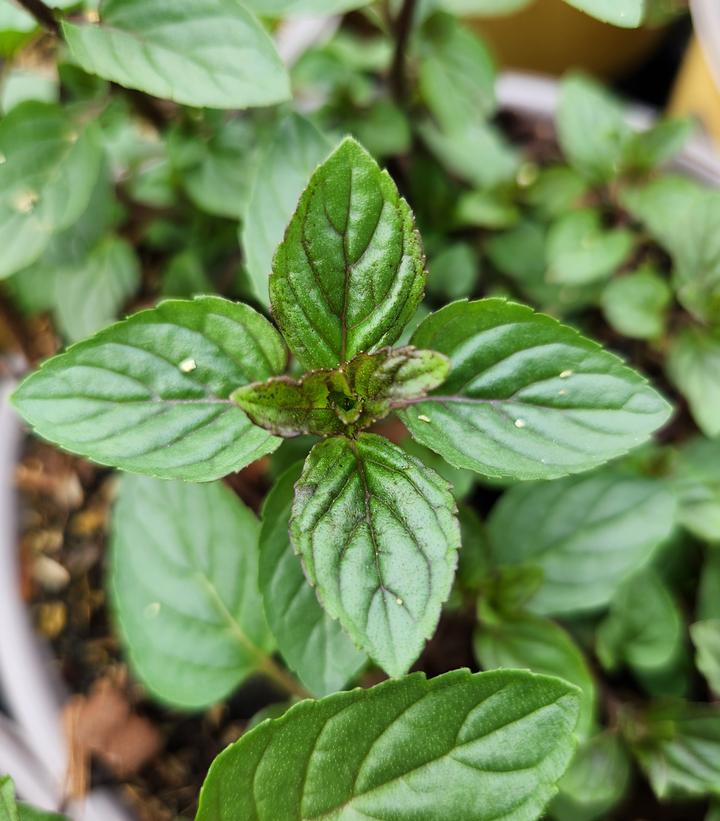« Previous Plant | Next Plant »
Mentha x piperita
Peppermint
- » Strong grower
- » Strong and satisfying taste and aroma
- » Deep, purplish-green foliage
- » Perfect for different foods, teas, and even bathwater
- » Best in a pot or container

- Category:Edibles
- Breeder:Sara's Superb Herbs®
- Hardiness Zone:4-8
- Height:12-36 in
- Spread:3-4 ft
- Bloom Color: Green Shades
A strong grower with a strong, satisfying taste and aroma! Deep purplish-green foliage is perfect for flavoring candy, sweets and teas while even making bath water stimulating and refreshing! Perfect for full sun or partial shade, peppermint is best grown in a sunken pot in the garden or in a container to contain its invasive nature. Perennial.
Foliage Color
| • | Green |
Attracts Wildlife
| • | Attracts Butterflies |
Programs
| • | Sara's Superb Herbs |
Habit
| • | Mounding |
Additional Information about Mentha x piperita
M. x piperita is the most effective mint medicinally because it is the source for menthol. Menthol acts by stimulating the flow of bile to the stomach, which promotes digestion. It also acts as an antispasmodic, calming the action of muscles.
Peppermint is believed to be a hybrid between M. aquatica and M. spicata. It has long stalks and broad flower spikes with purplish stems and leaves. The leaves are smooth, lanceolate, and toothed. The lilac-pink flowers are sterile.
Most mints (Mentha) are native to Europe and Asia. Some are native to North and South America, South Africa, and Australia. It is now naturalized from southern Canada to Mexico. The Pharisees in Biblical times paid taxes with mint. The Greeks used it in medicine and in temple rituals. It was strewn to refresh the air in homes and hospitals. Because Philemon and Baucis rubbed the table with mint before serving a meal to Zeus and Hermes, who had been traveling incognito and who had been snubbed by villagers, it has become a symbol of hospitality.
The word mint comes from Minthe, a Greek nymph who had the misfortune to be loved by Pluto. Persephone, not taking kindly to this infidelity, changed her into a lowly plant. But Pluto, taking pity on her, softened her plight by making her fragrant and even more aromatic when tread upon.
Harvest and Use: Peppermint and spearmint were brought to the New World by the colonists to be used as a beverage and as a medicinal. It now has many uses as a medicinal, a culinary, an aromatic, an ornamental, and as a cosmetic.
Mints are a complex group. They hybridize in the wild and under cultivation, often making individual plants hard to identify. It is best to buy plants from a reputable nursery, as mint often does not come true from seed. It is menthol that gives mints their typical smell and taste. It has so many uses that it would be hard to find someone who couldn't use it. Here is one medicinal that tastes good, too.
As is true for all herbs, fresh is best. Dried or frozen are good alternatives. It can also be stored in oil or vinegar. The following syrup is another convenient way to preserve peppermint: Simmer 4 cups of peppermint for 30 minutes in just enough water to cover.
Strain. For each cup of liquid add a cup of sugar, and simmer for 15 minutes. Bottle, label, and date. This may also be frozen in convenient portions.
Begin harvesting as soon as it comes up in spring. The main harvest should be taken as flowering begins.
Growing & Maintenance Tips for Mentha x piperita
Cultivation: Mints are square-stemmed perennials with tiny pink, purple, or white whorls of flowers on spikes. They grow about 2'tall and are very fragrant. They are hardy to zone 4.
All mints are invasive. To contain them, sink in the ground a bottomless 5-gallon pot with at least a 10-inch height (size of the pot really depends on how much space you want to allocate). Plant your mint in this. The rhizomes are contained by the pot. Never till mints because each stub will become another plant. If you want to grow several varieties, do not plant them close to each other because they will cross-pollinate freely (interbreed) and eventually different varieties will become indistinguishable.
When locating mints, remember that they all thrive in shade and like lots of moisture. They also like well-drained soil, but too much manure of organic matter encourages rust. Frequent cutting keeps mints at their prettiest because it forces them to branch and bush out. In the fall, cut back to the ground. This eliminates places for mint pests to over-winter. In companion planting, grow them where you need to repel aphids, flea beetles, and various cabbage pests. For fleas on your pets, try pennyroyal (Mentha pulegium), which has been used as a flea-repelling herb since the time of the ancient Greeks.
Propagation: Since mints do not come true from seed, propagate them by rhizome cuttings in early spring, by dividing in the fall, or by softwood cuttings in summer. Mints grow by putting out creeping roots (rhizomes). To propagate, first prepare containers or an area in the garden where you will replant the mint. If you are going to grow them in a pot, make sure the medium is loose and drains well—1/2 part peat to1/2 part perlite. Water the medium well and allow it to drain. Lift the plant and remove some healthy "roots". Choose those of average thickness. Cut into 1 to 3 inch sections that have at least one growth bud. Cut the crown straight across and the root tip at an angle so you will know which end to place up. Insert into the medium vertically with the bud toward the top. Water, label, and date. Keep the pots in a bright place at 50°F or above. Water again only when you see growth, and fertilize. Make sure the cutting has set roots before transplanting. It can start to grow quite deceivingly before establishing roots. In cold climates, harden off by putting pots of rooted cuttings out in the day and in a cool greenhouse at night.
Pests: Mints are susceptible to verticillium wilt, mint rust, and anthracnose. Mint pests include spider mites, aphids, and mint flea beetles.
